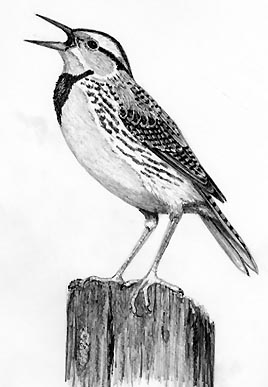
Dear Bird Folks,
I grew up out west where bluebirds and meadowlarks would sit on fence posts and fly over the open fields. In the ten years I’ve lived on Cape Cod I have not seen one meadowlark. Is there a way I can encourage meadowlarks to return so their population can rebound like the bluebirds have?
-Tom, Chatham
I’m With You Tom,
I love to see those handsome meadowlarks with their bright yellow bellies, flying over the fields. But have you ever noticed that in just about every picture you see of a meadowlark, the bird has its mouth open? Check it out sometime; it’s weird. Most people think they are singing. I think they are yawning because they are bored with sitting on a fence post all day, but I can’t prove it.
Meadowlarks are one of those birds with a slightly misleading name. When I think of a meadow I picture a soggy field of spring flowers, like they used to have in New Jersey before pavement made it the “Meadowlands.” Meadowlarks actually prefer dryer pasture lands. But since ‘Dry-pasture-land-lark” was too long of a name to fit on birding check lists, they went with the shorter meadow version. The other thing is that they really aren’t larks. They are actually in the blackbird family. So except for those two minor issues, the meadowlark’s name fits the bird perfectly.
Whether it be a meadow or a pasture, meadowlarks are birds of open areas. Their need for open habitat is the major reason why there are so few meadowlarks around here and their population is dropping. Years ago, when small farms dotted the landscape, meadowlarks had plenty of fields to build their nests in. But in more recent times the most often cultivated local crops are housing developments. And even if a field is undeveloped, it is usually left unattended, allowing trees and shrubs to take over. Of course many birds thrive in trees and shrubs, but meadowlarks aren’t one of them.
Most likely meadowlarks evolved in the vast grasslands of the Great Plains, where there were no trees to build the nests in. The meadowlarks were fine with that. They didn’t need no stinkin’ trees, they simply built their nests on the ground. Using available material, the female would make a dome-shaped nest out of grass. An umbrella of soft grass is all that separated the baby birds from a world of predators. Still, more often than not, the grass dome did its job and the baby birds successfully fledged.
There is, however, one predator that a grass dome can’t protect the birds from: the farmer’s mowing machine. As agricultural practice changed, farmers found ways to produce more from less. Pastures are cut more often, sometimes before the birds have finished nesting. The end result is not pretty. The irony is that the farmer benefits from the birds and their feeding habits. Meadowlarks eat tons of insects, many of which are on the farmer’s hate list.
Oddly there are two species of meadowlarks, an eastern and a western version. I say oddly because even though they are two distinct species, the two birds appear virtually identical. The best way to tell the two birds apart is by their songs. The eastern birds’ have a melodic song of five note whistles, while the western birds’ song is often accompanied by fiddles, a banjo and the occasional harmonica.
Meadowlarks are hardy birds that can survive the blazing heat of a western summer, as well as the frigid temperatures of a New England winter. Remember several winters ago when Eastham had all those pilot whale strandings? (Even if you don’t, just nod yes so I can continue.) I was birding along Boat Meadow Beach when I came upon the whales. Nobody else had spotted the whales yet, at least not this batch. There were no people with buckets, no helicopters, no TV crews from Boston, just me. As I approached the whales, a flock of meadowlarks flew overhead. Like you Tom, I hadn’t seen these colorful birds for many years. I was so thrilled to see them that I followed the flock back over the dunes and totally forgot about the whales until I got home and saw them being featured on the evening news. Oops.
There isn’t a whole bunch you can do for the meadowlarks, Tom, without investing in several farms and grasslands, which is what some towns have done. Mass. Audubon has preserved the Daniel Webster farm in Marshfield and the meadowlarks love it. You should check it out sometime. The birds will be waiting with open arms and open mouths.